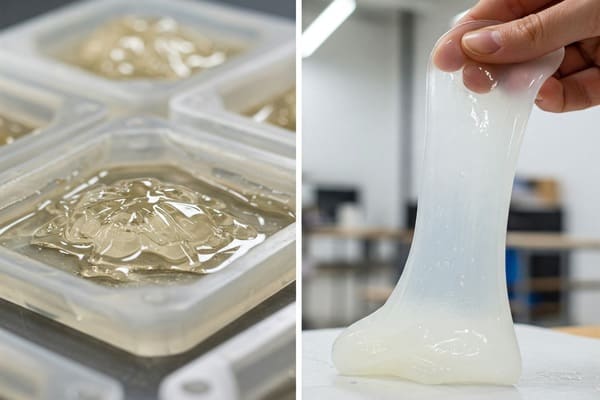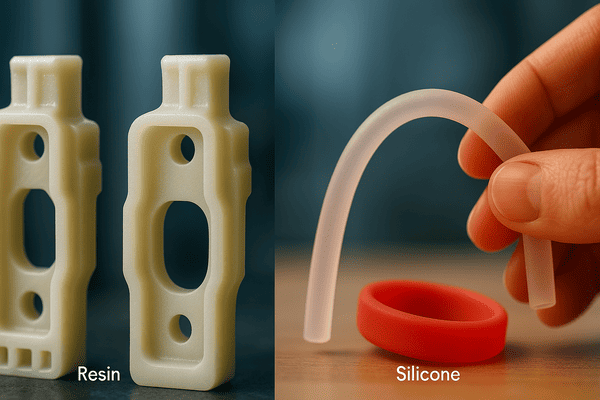Are you confused by the terms "resin" and "silicone"? These two materials may look similar, but they have distinct properties and uses. Understanding their differences will help you decide which one is right for your application.
Resin is a solid or liquid polymer used in casting and molding, while silicone is a flexible elastomer known for its heat resistance, durability, and elasticity. They differ in their curing processes, properties, and applications.

Silicone and resin are often used in manufacturing processes, but they serve different purposes depending on your project’s needs. Let’s explore how they differ in composition, properties, and common applications.
What Is Resin?
What exactly is resin? You might be surprised at how many types of resin exist and what they’re used for.
Resin is a liquid or solid polymer that hardens when mixed with a catalyst. It’s used in molding and casting for a wide range of applications, from artwork to industrial components.
Resin is a category of materials, typically derived from plant saps or synthetically made through chemical processes. The two most common types of resin used in manufacturing are epoxy resin1 and polyester resin2. These materials are known for their ability to harden into a durable plastic-like material when mixed with a hardener or catalyst.
Resin is primarily used for applications that require rigid, durable parts, including automotive components, jewelry, coatings, and art. Artists often use resin for casting decorative objects, while industries like automotive, aerospace, and construction utilize resin for its strength and bonding properties in composite materials.
| Property | Resin | Silicone |
|---|---|---|
| State | Liquid or solid after curing | Solid, flexible material |
| Flexibility | Rigid after curing | Highly flexible and elastic |
| Temperature Resistance | Moderate (up to 150°C) | High (up to 250°C) |
| Applications | Automotive, art, jewelry, coatings | Medical devices, seals, cookware |
What Is Silicone?
Silicone is often compared to resin but serves a different purpose in various industries. Let’s break down its properties and common uses.
Silicone is a versatile elastomer known for its flexibility, heat resistance, and chemical stability, often used for seals, gaskets, medical devices, and cookware.

Silicone is a synthetic polymer made from silicon, oxygen, carbon, and hydrogen. Unlike resin, silicone3 remains flexible and elastic even at high temperatures, making it an ideal material for parts that must maintain flexibility and performance under stress. Silicone is highly valued for its resistance to UV light, ozone, and temperature extremes, making it perfect for applications in harsh environments.
Common uses for silicone include medical devices, automotive seals, gaskets, cookware, and consumer electronics. Silicone’s temperature resistance4, ranging from -50°C to +250°C, and its biocompatibility5 make it especially useful in medical devices that require sterilization or prolonged exposure to bodily fluids.
| Property | Resin | Silicone |
|---|---|---|
| State | Liquid or solid after curing | Solid, flexible material |
| Flexibility | Rigid after curing | Highly flexible and elastic |
| Temperature Resistance | Moderate (up to 150°C) | High (up to 250°C) |
| Applications | Automotive, art, jewelry, coatings | Medical devices, seals, cookware |
Is Silicone a Resin?
You might be wondering if silicone is considered a type of resin. Let’s clear up the confusion.
No, silicone is not a resin. Although both are synthetic polymers, silicone is an elastomer, meaning it retains flexibility6, whereas resin is typically rigid after curing.
Silicone and resin both belong to the category of polymers, but they are fundamentally different in terms of their chemical structures and properties. Resin is a hard plastic material that sets rigid after curing, while silicone is an elastomer that remains flexible and elastic, even at high temperatures. The key distinction is that silicone has a unique chemical structure that gives it the ability to stretch and return to its original form, whereas resin lacks this ability and is typically brittle once cured.
Silicone’s structure allows it to withstand extreme temperatures and environmental conditions, making it suitable for sealing, gasketing, and applications where flexibility is essential. In contrast, resin is preferred in applications requiring rigid components, such as in casting molds, jewelry, and reinforced composite materials.
| Material | Type | Flexibility | Temperature Resistance | Common Uses |
|---|---|---|---|---|
| Silicone | Elastomer | High | Very High (up to 250°C) | Seals, medical devices, cookware |
| Resin | Thermoset Plastic | Low | Moderate (up to 150°C) | Art, automotive parts, coatings |
What Materials Are in Resin?
Ever wondered what exactly goes into resin? Understanding its components will help you know how to choose the right resin for your project.
Resin typically consists of a base material, such as epoxy or polyester, and a hardening agent or catalyst. Fillers, pigments, and additives are also used to modify its properties.
Resin is composed of several key materials, including the base polymer and a hardener or catalyst. The most common resins include:
- Epoxy Resin: Known for its strong bonding and durability, epoxy resin is often used in coatings, adhesives, and composite materials.
- Polyester Resin: Typically used in fiberglass production and boat manufacturing, polyester resin offers good strength and flexibility but has lower chemical resistance than epoxy.
- Vinyl Ester Resin7: A blend of epoxy and polyester resins, vinyl ester offers high resistance to corrosion and is used in high-performance applications.
Additives like colorants, fillers (e.g., glass fiber for reinforcement), and stabilizers may be added to enhance specific properties such as strength, flexibility, or UV resistance. These materials allow resin to be customized for a wide range of applications, from art to industrial manufacturing.
| Resin Type | Common Additives | Key Properties | Common Applications |
|---|---|---|---|
| Epoxy Resin | Hardeners, fillers | Strong adhesion, chemical resistance | Coatings, adhesives, art |
| Polyester Resin | Glass fibers, pigments | Moderate strength, low cost | Fiberglass, boat construction |
| Vinyl Ester Resin | Fibers, stabilizers | High corrosion resistance | Aerospace, marine, industrial |
Which Is Better, Resin or Silicone?
Are you debating whether resin or silicone is the better option for your project? The answer depends on the specific requirements of your application.
Resin is better for creating rigid, durable parts, while silicone excels in flexibility, heat resistance, and biocompatibility. Your choice depends on the need for rigidity versus flexibility, temperature resistance, and environmental conditions.

Deciding whether resin or silicone is the better choice for your application depends on several factors:
- Flexibility: If your application requires flexibility, silicone is the clear choice due to its elastic properties. Resin is rigid and can be brittle once cured.
- Temperature Resistance: Silicone performs better in extreme heat and cold, whereas resin typically has lower temperature tolerance. Silicone can withstand temperatures as high as 250°C, while resin is usually limited to around 150°C.
- Applications: Resin is better suited for applications requiring structural integrity, such as casting parts or creating composite materials. Silicone is preferred when flexibility, high temperature, and chemical resistance are required, such as in seals, gaskets, and medical devices.
- Biocompatibility: Silicone is often used in medical and food-contact applications because it is biocompatible, whereas resin may not be suitable for these applications due to potential toxicity or chemical release.
| Factor | Resin | Silicone |
|---|---|---|
| Flexibility | Rigid, brittle when cured | Highly flexible and elastic |
| Temperature Resistance | Moderate (up to 150°C) | High (up to 250°C) |
| Durability | Strong in structural applications | Exceptional in extreme environments |
| Applications | Art, automotive, construction | Medical, automotive, cookware |
Conclusion
Resin and silicone each have their own strengths, making them ideal for different uses. Resin is best for rigid, structural applications requiring durability and strength, such as automotive parts and art. Silicone, on the other hand, excels in flexible applications requiring high-temperature resistance, chemical stability, and biocompatibility, making it perfect for medical devices, automotive seals, and consumer goods. By understanding their differences, you can select the best material for your project’s needs.
🚀 Need Custom Resin or Silicone Solutions?
Contact Julong Rubber today or Request a Custom Quote for tailored resin and silicone products that meet your specifications!
Explore the advantages of epoxy resin, including its strong bonding and durability, essential for various applications. ↩
Learn about polyester resin's role in fiberglass production and its properties that make it suitable for various applications. ↩
Discover the versatility of silicone and its applications in medical devices, automotive, and cookware, showcasing its unique properties. ↩
Exploring temperature resistance helps in choosing the right materials for applications exposed to extreme heat or cold. ↩
Understanding biocompatibility is crucial for selecting materials for medical devices and applications involving bodily contact. ↩
Flexibility is a key property that affects the performance of materials in various applications, especially in seals and gaskets. ↩
Discover the high corrosion resistance of Vinyl Ester Resin and its suitability for high-performance applications. ↩






